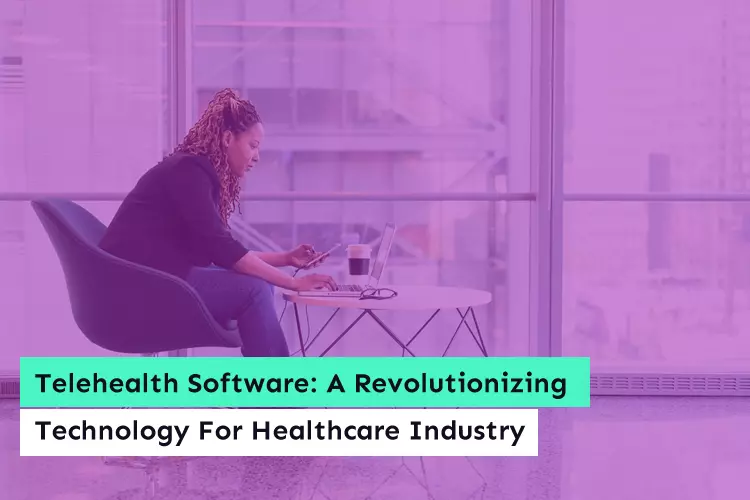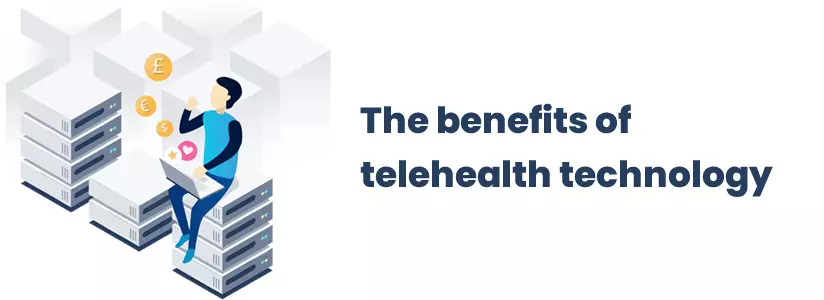Telehealth Software: A Revolutionizing Technology For Healthcare Industry

The relationship between healthcare and technology always has an active status. But the immediate demands and uncontrollable situations of coronavirus pandemic deepen the bond towards a more permanent status.
For over decades, technology has been advancing the healthcare domain, and the pandemic has hastened its presence virtually for patients as well.
Getting medical care in remote areas requires a 24×7 active system. Before the pandemic having a video call with your doctor was practically unheard of. There has been rapid adoption of telehealth in the past two years due to the worldwide restrictions of social distancing and the added risk of coronavirus infection.
We have come out of a global health crisis, which has changed the course of medicine in many ways. The comfort and security presented with the collaboration of IT and healthcare are bound to go further. There is no doubt that we will see more intelligent apps software for more problems in the digital health sector.
The rise of telemedicine
According to a report by CDC, almost 95% of healthcare providers provide telehealth services to patients in the United States. In 2019, the percentage was just 43!
Not just from the health perspective, even the business side of telehealth has been booming. In 2021, US-based startups secured a total digital health funding of $29.1 billion! Which is twice as much compared to the previous year.
Also Read: Hiring Offshore Software Companies In 2022? Here Are The Top Models To Pick From
Many experts agree that these numbers are proof of the long-awaited collision of the IT and healthcare sectors. The technological integration in the medical field continues to advance. Much like the internet has changed the way people live, shop, communicate, telehealth is set to disrupt the wellness market and how people get treated.
What does telehealth mean?
Telehealth is when you use a mobile or PC to talk to a doctor, physician, or nurse. Using telehealth means you can book a health appointment anywhere, even from home. It also lowers your risk of getting infected or making other people sick.
For a highly contagious disease or a new one (like COVID – 19), telehealth medicine is the only option for patients to get medical help wherever they are.
Imagine a patient with a chronic condition being far away. How would telehealth help him? Here are a few of the ways:
- He can book a one on one video call with a specialist in the country
- Use a mobile, iPad, or computer to upload food logs, previous medications, doses, allergies and other health data
- Track all the health vitals with devices to be reviewed by a digital nurse
- Use portals to refill prescriptions, access test results and more
- Order monthly medicines on apps
- Get reminders of flu shots, timely checkups, and other cautions.
Also, telehealth technology is any app or software that evaluates, stores or shares a patient’s health info. Electronic health record softwares, patient portals, management systems for hospitals are all a part of this broad term. Telehealth, telemedicine, or health IT are all used in similar clinical care contexts, health information sharing and education from a distance.
Telehealth makes healthcare reach people who need it but cannot access it.
Types of telehealth services
Telehealth has been booming during the covid era, and now there are several variations of services available on the internet. But the major three include store and forward, remote monitoring, and real-time interaction.
Remote monitoring
Remote monitoring, sometimes also called self-monitoring or self-testing, is the
In remote monitoring, patients use a technological device, app, or software to monitor clinical signs and health vitals remotely. It is also known as self-monitoring or self-testing. It is best for managing patients with chronic conditions like asthma, diabetes, and heart problems.
Remote monitoring reduces the frequent hospital visits for patients, decreases unnecessary test bills and provides greater patient satisfaction. Although the risk of wrong test results is a concern, with sophisticated testing devices, the outcomes of patients are similar to professional results.
Store-and-forward
Store-and-forward is a convenient form of telemedicine for patients and medical practitioners. Data like images, vitals or biosignals can be sent digitally to the specialist as required. Store-and-forward eliminates the need for in-person visits of patients and doctors. For instance, if a doctor sends x-rays of a patient’s past injuries to a specialist in a big hospital, that’s a store and forward technology.
Store and forward technology allow healthcare professionals to serve their patients better. It saves a lot of time, but there might be compilations due to misdiagnosis. The information is old, and the previous results can’t be trusted completely.
Real-time interaction
Real-time audio and video calls are the first things that come to mind when someone hears about telehealth. Real-time interaction is similar to an actual call or video call with your doctor or nursing staff in different locations. Real-time interactions are also possible when moving the patient to a better facility is risky, and special consultation is required.
Also Read: microsoft power bi consulting services
Such interactive softwares and apps provide much better access and medical attention. One can use any device to connect with the doctor at home online. There are apps available where patients can upload all the medical history for assessment and diagnosis. An online interactive session can be followed by a personal visit for the best treatment.
The benefits of telehealth technology

Telehealth technology is a match made in heaven for the patients and providers. Here are the eye-opening advantages of telehealth and how it changes the face of the industry.
- Hospitals and institutions can cover a wider geographic location
- Doctors and nurses can devote their time to emergency cases and serious patients
- More patient care in less time, boosting the efficiency and revenue of the practice
- Better health outcomes for chronic patients due to close monitoring
- Video consultation outside the office hours without any expense
Even patients have loved the collaboration of technology and software.
There is a ton of data that reflects people’s liking for telehealth technology. Why wouldn’t they like world-class health services in the home? Of course, they enjoy it. Some of the undeniable benefits:
- No monthly checkups, bills, travelling for faraway patients with chronic ailments
- Less exposure to other sick patients in the hospitals (especially for contagious diseases)
- Satisfaction of uploading the correct medical history by themselves
- Easy management of illness and digital records
- More time for work and family
The goals of telehealth
Telehealth has many benefits for both patients and providers. The goals of this new developed e-health or m health tech ecosystem are following:
- Making healthcare cost-effective and less hectic for terminally ill patients
- Reaching out to the people in rural areas with limited transportation availability
- Offering specialist medical care for all
- More self-care options for patients staying home
- Quicker access to medical history, past reports and better management of medical data
- Improved communication between patients and healthcare team members.
Why telehealth is the future of the healthcare industry
As you must have observed with other aspects of the lifestyle, the world is moving towards digitization. Mobile-first technologies are everywhere, and healthcare is no different.
Technology will play an integral part in making healthcare accessible to everyone. The adoption of mobile and software has reduced costs and provided convenient services at home. Practices and organizations that have integrated technology will have increased revenue, better relationships with patients and beat the competition.
As an offshore software development company, we are proud to help make softwares that keep patients healthier and increase our customers’ profitability.
Don’t miss the best time to involve technology in your practice. Contact our team at Imenso Software for more details, queries and quotes.
Similar Posts

Telehealth Development- Transforming the future of healthcare
Telehealth is transforming how we get healthcare, and it is at the forefront of that shift. Telehealth, also known as telemedicine or e-health, is revolutionizing the healthcare industry by using technology to connect patients with medical professionals virtually. With the increasing demand for healthcare services and the limited resources available, telehealth has become an important […]...

How Can Small Business Cope With The Long-Term Effects Of Covid-19?
The Covid-19 crisis has been disruptive for many businesses, but the SMBs have had the major burn of all. There has been some relief in 2021 as the vaccines are here, and the lockdown has been removed. But things are still far from ordinary. And according to experts, it can be until august 2021 to […]...

Top Use Cases of Data Visualization Dashboards in Healthcare
The human eye is naturally drawn to pictures more than text lists. Therefore, it is not an exaggeration to claim that data science visualizations in healthcare are essential for saving lives. The healthcare sector is being shaken up by big data. Simply put, data visualization is the practice of displaying data graphically, such as through […]...







